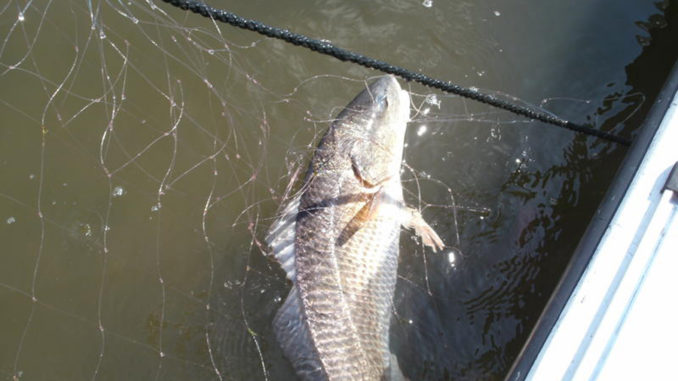
Commercial fishermen exceeded entire 2014 quota in 84 days last fall
The N.C. Division of Marine Fisheries has closed commercial fishing for red drum statewide because netters caught more than their allowable poundage for the entire season in just a few months last fall.
NCDMF announced on April 14 that the commercial fishery will be closed until at least Sept. 1 because it estimated that netters had caught 261,000 pounds, 11,000 more than the allowable quota.
“We knew we had an exceptionally good year class of red drum in the slot this year, but didn’t expect so many to be caught so quickly,” said Dr. Louis Daniel, director of the agency. “We are seeing some of the same year-class fish now in the good spring numbers in the recreational catch. We certainly had not anticipated that even with the exceptionally large year class so many red drum could be caught so quickly.
“When we looked at the trip tickets at the end of October, we realized there was potential for an overage in the catch,” Daniel said. “We … weren’t thinking about exceeding the total catch for the year. We examined the trip tickets the third week in November, and when the total was 144,258 pounds; I issued the proclamation to close the season. We were stunned when the reports containing all the written trip tickets were tallied later and the total exceeded the poundage for the annual catch.”
NCDMF divides the commercial season on red drum between Sept. 1-March 31 and April 1-Aug. 31. Fishermen were allowed to catch 150,000 pounds in the September-to-March season; they actually caught 261,000. The agency said that the 11,000 pounds of overage will be deducted from the allowable catch for the 2015 season.
The 2014 fall/winter commercial season opened on Sept. 1, 2013, even though much of the fishable water south of Oregon Inlet was off limits to large-mesh gill nets due to closures caused by the presence of endangered sea turtles. Most of these areas opened to large mesh gill nets almost a month later.
The fall/winter commercial season was closed on Nov. 23, 2013, after only 84 days. A review of electronic trip-ticket records showed 144,258 of the allowed 150,000 pounds had been caught by the end of the third week of November, and NCDMF staffers knew paper trip tickets had not been tallied. When they were tallied, the total catch for these 84 days reached 260,866 pounds.
Daniel said the N.C. Marine Fisheries Commission will almost certainly have to face up to the overages at its May meeting and figure out what to do in the future.
“Tre has been a lot of discussion on this already, and it will be a primary topic of the May … meeting,” Daniel said. “I expect to see suggestions from all across the board. The commissioners have ideas, and our staff has offered some ideas and suggested modifications to the fishery.”
The commercial red drum fishery is classified as a by-catch fishery to allow netters to keep and sell reds caught in gill nets that are set to target other species. The daily catch limit of 10 fish is supposed to allow a few drum caught incidentally to be kept and sold, but not enough to make reds a targeted species. The by-catch limit began at five, was raised to seven and then raised again to the current limit of 10. Among other things, that number will likely be re-examined.
“I’m sure we will spend a lot of time on this at the May MFC meeting,” said Joe Shute of Atlantic Beach, a fishing guide who holds a recreational industry seat on the Marine Fisheries Commission. “I am on the record from the November meeting as saying electronic trip-ticket reporting must be required, and I stand by that. This isn’t new; it’s simply mirroring the federal reporting requirements. In this day and age, and especially with so many species being managed so closely, having a computer and reporting trip tickets electronically and frequently must be a requirement for all seafood dealers.
“I’m also looking forward to hearing the ideas of the other commissioners and the recommendations from the biologists at the division,” Shute said. “This is a big deal and we need to get a handle on it as quickly as possible.”
Dr. Chris Elkins, a retired microbiologist from UNC and chairman of the CCA-NC Fisheries Committee, sees the overage of 73.9 percent of the fall/winter season cap as blatant illegal targeting of red drum by commercial fishermen.
“The original rules allowed a five red drum by-catch so long as an equal weight of southern flounder was caught,” Elkins said. “When these rules were in effect, less than five percent of the trip tickets reporting red drum showed the maximum five fish, indicating that fishermen rarely if at all targeted red drum.
“Subsequently, the rule was changed from five red drum to seven and later to 10 fish per day, and disturbingly, the requirement for only Southern flounder serving as the targeted fish was changed to any finfish except menhaden,” Elkins said. “Red drum are easily targeted because they school up in shallow water and are very predictable. A fisherman with a strike net can circle a whole school in 30 seconds. We must stop the illegal targeting of red drum by changing the rules back to the original ones.”
Greg Hurt, the chairman of CCA-NC, said, “The association is obviously very concerned about the significant amount that the commercial red drum quota was exceeded. The amount of the overage is of a level that confirms some commercial fishermen are clearly targeting red drum. Red drum are designated as an incidental catch not a directed fishery as was the case last fall.”



